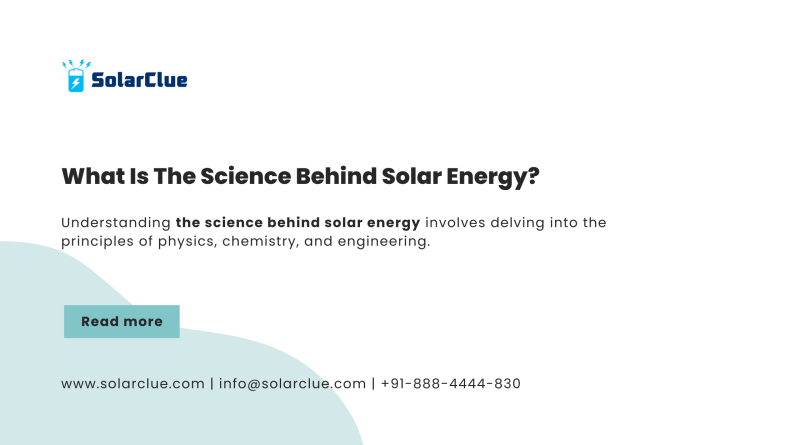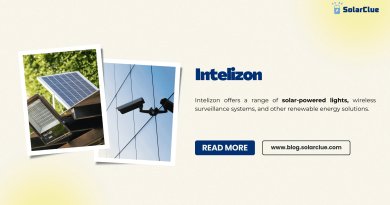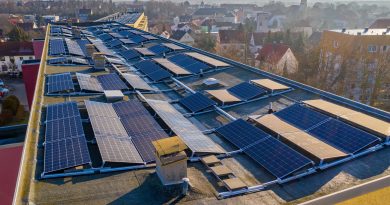What Is The Science Behind Solar Energy?
Solar energy is a fascinating and increasingly important field of study, driven by the need for sustainable and renewable energy sources. But how exactly does sunlight get transformed into electricity that powers our homes, businesses, and gadgets? Understanding the science behind solar energy involves delving into the principles of physics, chemistry, and engineering. In this blog, we’ll explore the key scientific concepts that make solar energy possible and provide a table summarizing these principles.
Table of Contents
The Basic Principles of Solar Energy
At its core, solar energy harnesses the power of the Sun, converting it into usable forms of energy, primarily electricity. This conversion relies on several key scientific principles:
1. The Sun as an Energy Source:
The Sun emits an enormous amount of energy, primarily in the form of light and heat, due to nuclear fusion reactions occurring in its core. These reactions combine hydrogen atoms to form helium, releasing vast amounts of energy in the process.
2. Electromagnetic Radiation:
The energy emitted by the Sun travels through space as electromagnetic radiation. This radiation includes a wide spectrum of wavelengths, from infrared to ultraviolet light, with visible light being the most important for solar energy.
3. The Photovoltaic Effect:
The photovoltaic effect is the process by which solar cells convert sunlight into electricity. When light photons strike the surface of a solar cell, they transfer their energy to electrons in the cell’s semiconductor material (usually silicon). This energy boost allows the electrons to break free from their atoms and flow through the material, creating an electric current.
4. Semiconductor Materials:
Semiconductor materials like silicon are crucial for solar energy conversion. These materials have properties that allow them to conduct electricity under certain conditions, making them ideal for capturing and converting sunlight into electrical energy.
5. P-N Junctions:
Solar cells are constructed with two types of semiconductor materials: p-type (positive) and n-type (negative). The interface between these materials, known as the p-n junction, is where the photovoltaic effect occurs. When sunlight hits the solar cell, it creates an electric field at the p-n junction, driving the flow of electrons and generating electricity.
6. Electrical Circuit:
The electrons that are knocked loose by sunlight in the solar cell flow through an external circuit, creating an electric current. This current can be used immediately to power devices or stored in batteries for later use.
7. Energy Conversion Efficiency:
Not all the sunlight that hits a solar panel is converted into electricity. The efficiency of a solar cell depends on various factors, including the quality of the semiconductor material, the wavelength of the sunlight, and the design of the solar cell. Typical commercial solar panels have an efficiency ranging from 15% to 22%.
The Science Behind Solar Energy: Key Concepts
| Concept | Explanation |
|---|---|
| Nuclear Fusion | The process occurring in the Sun’s core where hydrogen atoms combine to form helium, releasing energy in the form of light and heat. |
| Electromagnetic Radiation | Energy from the Sun travels through space as electromagnetic waves, including visible light, which is crucial for solar energy conversion. |
| Photovoltaic Effect | The phenomenon where photons from sunlight excite electrons in a semiconductor, generating an electric current. |
| Semiconductor Materials | Materials like silicon that have properties enabling them to conduct electricity when exposed to sunlight. |
| P-N Junction | The boundary between p-type and n-type semiconductors in a solar cell where the photovoltaic effect takes place, driving electron flow. |
| Electrical Circuit | The pathway through which electrons flow from the solar cell to generate usable electrical power. |
| Energy Conversion Efficiency | The percentage of sunlight that a solar cell can convert into electricity, typically ranging from 15% to 22% in commercial panels. |
How Solar Panels Work
To further understand the science behind solar energy, let’s take a closer look at how solar panels work:
1. Sunlight Hits the Solar Panel:
Sunlight, composed of photons, strikes the surface of the solar panel, which is made up of many solar cells.
2. Photovoltaic Effect in Action:
The energy from the photons is absorbed by the semiconductor material in the solar cells, usually silicon. This energy excites electrons, causing them to break free from their atoms.
3. Creation of an Electric Field:
The design of the solar cell, with its p-n junction, creates an electric field that directs these free electrons toward metal contacts on the cell’s surface.
4. Flow of Electricity:
The electrons flow through an external circuit, generating direct current (DC) electricity, which can be used immediately or stored in batteries.
5. Conversion to Usable Power:
In most cases, the DC electricity is converted to alternating current (AC) electricity using an inverter, making it compatible with the electrical systems in homes and businesses.
Conclusion
The science behind solar energy is a beautiful interplay of physics, chemistry, and engineering. By understanding the principles of nuclear fusion, electromagnetic radiation, and the photovoltaic effect, we can appreciate how solar panels harness the power of the Sun to generate clean, renewable electricity. As solar technology continues to advance, these principles will remain at the heart of efforts to create a more sustainable energy future.
Unlock the science behind solar energy and discover how you can turn sunlight into savings and sustainability. At SolarClue, we are dedicated to helping you harness this powerful, renewable energy source. Visit SolarClue to explore our range of cutting-edge solar solutions, tailored to meet your energy needs. Our team of experts will guide you through the science and technology, ensuring you get the most out of your solar investment. Don’t just learn about solar energy—experience its benefits firsthand with SolarClue.
Start your journey to clean, efficient energy today!




